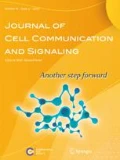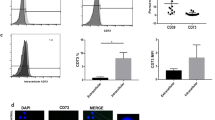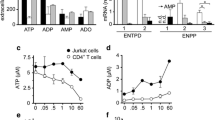Abstract
Purinergic signaling plays a complex role in inflammation. Nucleotides released by T lymphocytes, endothelial cells, and platelets during inflammation induce cellular responses by binding to receptors that regulate intracellular signaling pathways. Previous studies have found that purinergic signaling can have both proinflammatory and anti-inflammatory effects, but the roles of specific pathways in specific cell types are poorly understood. We investigated the role of the P2Y12 signaling pathway in the activation of T lymphocytes in vitro. We isolated peripheral blood mononuclear cells (PBMCs) from healthy donors and pretreated them with ADP (a P2Y12 agonist), AR-C69931MX (a P2Y12 antagonist), or both. We then stimulated PBMC using phytohemagglutinin (PHA) or anti-CD3/CD28 antibodies. We found that ADP affects T cell responses in term of cell activity and receptor expression through both P2Y12-dependent and P2Y12-independent pathways and other responses (cytokine secretion) primarily through P2Y12 -independent pathways. The ADP-mediated effect changed over time and was stimulus-specific.






Similar content being viewed by others
Abbreviations
- 2MeSADP:
-
2-methylthio-ADP
- GPCRs:
-
G protein-coupled receptors
- PBMCs:
-
Peripheral blood mononuclear cells
- PBS:
-
Phosphate-buffered saline
- PHA:
-
Phytohemagglutinin
References
Arvanitakis L, Geras-Raaka E, Gershengorn MC (1998) Constitutively signaling G-protein-coupled receptors and human disease. Trends Endocrinol Metab 9:27–31
Aungraheeta R, Conibear A, Butler M, Kelly E, Nylander S, Mumford A, Mundell SJ (2016) Inverse agonism at the P2Y12 receptor and ENT1 transporter blockade contribute to platelet inhibition by ticagrelor. Blood 128:2717–2728. https://doi.org/10.1182/blood-2016-03-707844
Ben Addi A, Cammarata D, Conley PB, Boeynaems JM, Robaye B (2010) Role of the P2Y12 receptor in the modulation of murine dendritic cell function by ADP. J Immunol 185:5900–5906. https://doi.org/10.4049/jimmunol.0901799
Bhavaraju K, Mayanglambam A, Rao AK, Kunapuli SP (2010) P2Y(12) antagonists as antiplatelet agents - recent developments. Curr Opin Drug Discov Devel 13:497–506
Boeynaems JM, Communi D (2006) Modulation of inflammation by extracellular nucleotides. J Invest Dermatol 126:943–944. https://doi.org/10.1038/sj.jid.5700233
Broker BM et al (1994) Engagement of the CD4 receptor inhibits the interleukin-2-dependent proliferation of human T cells transformed by Herpesvirus saimiri. Eur J Immunol 24:843–850. https://doi.org/10.1002/eji.1830240411
Burnstock G (2007) Purine and pyrimidine receptors. Cell Mol Life Sci 64:1471–1483. https://doi.org/10.1007/s00018-007-6497-0
Burnstock G (2018) The therapeutic potential of purinergic signalling. Biochem Pharmacol 151:157–165. https://doi.org/10.1016/j.bcp.2017.07.016
Campwala H, Sexton DW, Crossman DC, Fountain SJ (2014) P2Y(6) receptor inhibition perturbs CCL2-evoked signalling in human monocytic and peripheral blood mononuclear cells. J Cell Sci 127:4964–4973. https://doi.org/10.1242/jcs.159012
Cekic C, Linden J (2016) Purinergic regulation of the immune system. Nat Rev Immunol 16:177–192. https://doi.org/10.1038/nri.2016.4
Chen CJ, Chang SJ (2013) Purinergic signaling during inflammation. N Engl J Med 368:1260. https://doi.org/10.1056/NEJMc1300259#SA1
Chess L, Levine H, MacDermott RP, Schlossman SF (1975) Immunologic functions of isolated human lymphocyte subpopulations. VI. Further characterization of the surface Ig negative, E rosette negative (null cell) subset. J Immunol 115:1483–1487
de Swart RL et al (1993) Mitogen and antigen induced B and T cell responses of peripheral blood mononuclear cells from the harbour seal (Phoca vitulina). Vet Immunol Immunopathol 37:217–230. https://doi.org/10.1016/0165-2427(93)90195-a
Deaglio S, Robson SC (2011) Ectonucleotidases as regulators of purinergic signaling in thrombosis, inflammation, and immunity. Adv Pharmacol 61:301–332. https://doi.org/10.1016/B978-0-12-385526-8.00010-2
Di Virgilio F, Solini A (2002) P2 receptors: new potential players in atherosclerosis. Br J Pharmacol 135:831–842. https://doi.org/10.1038/sj.bjp.0704524
Eltzschig HK, Sitkovsky MV, Robson SC (2013) Purinergic signaling during inflammation. N Engl J Med 368:1260. https://doi.org/10.1056/NEJMc1300259
Gendaszewska-Darmach E, Maszewska M, Zaklos M, Koziolkiewicz M (2003) Degradation of extracellular nucleotides and their analogs in HeLa and HUVEC cell cultures. Acta Biochim Pol 50:973–984. https://doi.org/10.035004973
Gu BJ, Zhang WY, Bendall LJ, Chessell IP, Buell GN, Wiley JS (2000) Expression of P2X(7) purinoceptors on human lymphocytes and monocytes: evidence for nonfunctional P2X(7) receptors. Am J Phys Cell Physiol 279:C1189–C1197. https://doi.org/10.1152/ajpcell.2000.279.4.C1189
Hackert T, Sperber R, Hartwig W, Fritz S, Schneider L, Gebhard MM, Werner J (2009) P-selectin inhibition reduces severity of acute experimental pancreatitis. Pancreatology 9:369–374
Hagiwara S, Iwasaka H, Hasegawa A, Oyama M, Imatomi R, Uchida T, Noguchi T (2011) Adenosine diphosphate receptor antagonist clopidogrel sulfate attenuates LPS-induced systemic inflammation in a rat model. Shock 35:289–292. https://doi.org/10.1097/SHK.0b013e3181f48987
Harada K, Matsumoto Y, Umemura K (2011) Adenosine diphosphate receptor P2Y12-mediated migration of host smooth muscle-like cells and leukocytes in the development of transplant arteriosclerosis. Transplantation 92:148–154
Hardy AR, Conley PB, Luo J, Benovic JL, Poole AW, Mundell SJ (2005) P2Y1 and P2Y12 receptors for ADP desensitize by distinct kinase-dependent mechanisms. Blood 105:3552–3560. https://doi.org/10.1182/blood-2004-07-2893
Hasham MG, Tsygankov AY (2004) Tip, an Lck-interacting protein of Herpesvirus saimiri, causes Fas- and Lck-dependent apoptosis of T lymphocytes. Virology 320:313–329. https://doi.org/10.1016/j.virol.2003.11.032
Hoffman JF, Dodson A, Wickrema A, Dib-Hajj SD (2004) Tetrodotoxin-sensitive Na+ channels and muscarinic and purinergic receptors identified in human erythroid progenitor cells and red blood cell ghosts. Proc Natl Acad Sci U S A 101:12370–12374. https://doi.org/10.1073/pnas.0404228101
Ibrahim M, Wang X, Puyo CA, Montecalvo A, Huang HJ, Hachem RR, Andreetti C, Menna C, Chen R, Krupnick AS, Kreisel D, Rendina EA, Gelman AE (2015) Human recombinant apyrase therapy protects against canine pulmonary ischemia-reperfusion injury. J Heart Lung Transplant 34:247–253. https://doi.org/10.1016/j.healun.2014.09.034
Idzko M, Ferrari D, Riegel AK, Eltzschig HK (2014) Extracellular nucleotide and nucleoside signaling in vascular and blood disease. Blood 124:1029–1037. https://doi.org/10.1182/blood-2013-09-402560
Ingall AH, Dixon J, Bailey A, Coombs ME, Cox D, McInally J, Hunt SF, Kindon ND, Teobald BJ, Willis PA, Humphries RG, Leff P, Clegg JA, Smith JA, Tomlinson W (1999) Antagonists of the platelet P2T receptor: a novel approach to antithrombotic therapy. J Med Chem 42:213–220. https://doi.org/10.1021/jm981072s
Jacob F, Perez Novo C, Bachert C, Van Crombruggen K (2013) Purinergic signaling in inflammatory cells: P2 receptor expression, functional effects, and modulation of inflammatory responses. Purinergic Signal 9:285–306. https://doi.org/10.1007/s11302-013-9357-4
Junger WG (2011) Immune cell regulation by autocrine purinergic signalling. Nat Rev Immunol 11:201–212. https://doi.org/10.1038/nri2938
Kaczmarek-Hajek K, Lorinczi E, Hausmann R, Nicke A (2012) Molecular and functional properties of P2X receptors--recent progress and persisting challenges. Purinergic Signal 8:375–417. https://doi.org/10.1007/s11302-012-9314-7
Kim S, Kunapuli SP (2011) P2Y12 receptor in platelet activation. Platelets 22:56–60. https://doi.org/10.3109/09537104.2010.497231
Kim YC, Lee JS, Sak K, Marteau F, Mamedova L, Boeynaems JM, Jacobson KA (2005) Synthesis of pyridoxal phosphate derivatives with antagonist activity at the P2Y13 receptor. Biochem Pharmacol 70:266–274. https://doi.org/10.1016/j.bcp.2005.04.021
Kronlage M et al (2010) Autocrine purinergic receptor signaling is essential for macrophage chemotaxis. Sci Signal 3:ra55. https://doi.org/10.1126/scisignal.2000588
Layhadi JA, Turner J, Crossman D, Fountain SJ (2018) ATP evokes Ca(2+) responses and CXCL5 secretion via P2X4 receptor activation in human monocyte-derived macrophages. J Immunol 200:1159–1168. https://doi.org/10.4049/jimmunol.1700965
Li P, Cao J, Chen Y, Wang W, Yang J (2014) Apyrase protects against allergic airway inflammation by decreasing the chemotactic migration of dendritic cells in mice. Int J Mol Med 34:269–275. https://doi.org/10.3892/ijmm.2014.1771
Liu Y et al (2011) Novel role of platelets in mediating inflammatory responses and ventricular rupture or remodeling following myocardial infarction. Arterioscler Thromb Vasc Biol 31:834–841
Liverani E, McLeod JD, Paul C (2012) Adrenomedullin receptors on human T cells are glucocorticoid-sensitive. Int Immunopharmacol 14:75–81. https://doi.org/10.1016/j.intimp.2012.06.011
Liverani E, Rico MC, Yaratha L, Tsygankov AY, Kilpatrick LE, Kunapuli SP (2014) LPS-induced systemic inflammation is more severe in P2Y12 null mice. J Leukoc Biol 95:313–323. https://doi.org/10.1189/jlb.1012518
Liverani E, Rico MC, Tsygankov AY, Kilpatrick LE, Kunapuli SP (2016) P2Y12 receptor modulates sepsis-induced inflammation. Arterioscler Thromb Vasc Biol 36:961–971. https://doi.org/10.1161/ATVBAHA.116.307401
Marteau F, le Poul E, Communi D, Communi D, Labouret C, Savi P, Boeynaems JM, Gonzalez NS (2003) Pharmacological characterization of the human P2Y13 receptor. Mol Pharmacol 64:104–112
Micklewright JJ, Layhadi JA, Fountain SJ (2018) P2Y12 receptor modulation of ADP-evoked intracellular Ca(2+) signalling in THP-1 human monocytic cells. Br J Pharmacol 175:2483–2491. https://doi.org/10.1111/bph.14218
Qin C et al (2017) Critical role of P2Y12 receptor in regulation of Th17 differentiation and experimental autoimmune encephalomyelitis pathogenesis. J Immunol 199:72–81. https://doi.org/10.4049/jimmunol.1601549
Rayah A, Kanellopoulos JM, Di Virgilio F (2012) P2 receptors and immunity. Microbes Infect 14:1254–1262. https://doi.org/10.1016/j.micinf.2012.07.006
Sak K, Boeynaems JM, Everaus H (2003) Involvement of P2Y receptors in the differentiation of haematopoietic cells. J Leukoc Biol 73:442–447
Sasaki Y, Hoshi M, Akazawa C, Nakamura Y, Tsuzuki H, Inoue K, Kohsaka S (2003) Selective expression of Gi/o-coupled ATP receptor P2Y12 in microglia in rat brain. Glia 44:242–250
Sevigny J, Martin-Satue M, Pintor J (2015) Purinergic signalling in immune system regulation in health and disease. Mediat Inflamm 2015:106863. https://doi.org/10.1155/2015/106863
Shinohara Y, Tsukimoto M (2017) Adenine nucleotides attenuate murine T cell activation induced by concanavalin A or T cell receptor stimulation. Front Pharmacol 8:986. https://doi.org/10.3389/fphar.2017.00986
Sullivan KE, Cutilli J, Piliero LM, Ghavimi-Alagha D, Starr SE, Campbell DE, Douglas SD (2000) Measurement of cytokine secretion, intracellular protein expression, and mRNA in resting and stimulated peripheral blood mononuclear cells. Clin Diagn Lab Immunol 7:920–924
Trabanelli S et al (2012) Extracellular ATP exerts opposite effects on activated and regulatory CD4+ T cells via purinergic P2 receptor activation. J Immunol 189:1303–1310. https://doi.org/10.4049/jimmunol.1103800
von Kugelgen I (2006) Pharmacological profiles of cloned mammalian P2Y-receptor subtypes. Pharmacol Ther 110:415–432
von Kugelgen I, Hoffmann K (2016) Pharmacology and structure of P2Y receptors. Neuropharmacology 104:50–61. https://doi.org/10.1016/j.neuropharm.2015.10.030
Wang L, Ostberg O, Wihlborg AK, Brogren H, Jern S, Erlinge D (2003) Quantification of ADP and ATP receptor expression in human platelets. J Thromb Haemost 1:330–336
Wang L, Jacobsen SE, Bengtsson A, Erlinge D (2004) P2 receptor mRNA expression profiles in human lymphocytes, monocytes and CD34+ stem and progenitor cells. BMC Immunol 5:16. https://doi.org/10.1186/1471-2172-5-16
Acknowledgments
This work was supported by the American Heart Association grant 16SDG26980003 to EL.
Author information
Authors and Affiliations
Corresponding author
Additional information
Publisher’s note
Springer Nature remains neutral with regard to jurisdictional claims in published maps and institutional affiliations.
Electronic supplementary material
ESM 1
(DOCX 22 kb)
Supplemental Figure 1
Flow cytometric gating strategy to define T cell populations. Supplemental Fig. 2: CD4+, CD8+ and CD4+/CD25+ cell populations at time 0. The percentage of PBMC cell population was characterized at time 0. The percentage of CD4, CD8, CD4 + CD25, CD19 and CD14 (black dots) were analyzed in PBMC after isolation. The isotype control is shown in red. Data are expressed as % of expression ± S.E.M. (n = 3). Supplemental Fig. 3: Cell viability. Cell viability was determined with propidium iodide exclusion, while apoptosis was assessed as Annexin V expression. Cells negative for both were considered viable. (PPTX 205 kb)
Rights and permissions
About this article
Cite this article
Vemulapalli, H., Albayati, S., Patwa, V.C. et al. ADP exerts P2Y12 -dependent and P2Y12 -independent effects on primary human T cell responses to stimulation. J. Cell Commun. Signal. 14, 111–126 (2020). https://doi.org/10.1007/s12079-019-00540-8
Received:
Accepted:
Published:
Issue Date:
DOI: https://doi.org/10.1007/s12079-019-00540-8




